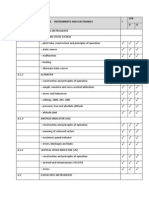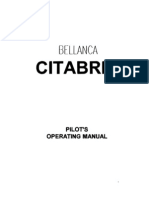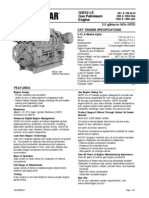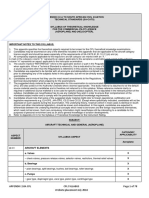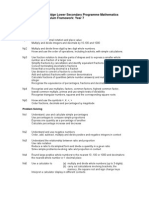SACAA ATPL ATG Syllabus
SACAA ATPL ATG Syllabus
Uploaded by
Osa AigCopyright:
Available Formats
SACAA ATPL ATG Syllabus
SACAA ATPL ATG Syllabus
Uploaded by
Osa AigOriginal Description:
Copyright
Available Formats
Share this document
Did you find this document useful?
Is this content inappropriate?
Copyright:
Available Formats
SACAA ATPL ATG Syllabus
SACAA ATPL ATG Syllabus
Uploaded by
Osa AigCopyright:
Available Formats
ATP syllabus ATG(A)
1
REF
6.1 AIRCRAFT TECHNICAL AND GENERAL
AEROPLANE
A
6.1.1 AIRFRAME AND SYSTEMS
6.1.1.1 Fuselage
types of construction
structural components and materials used
stress
6.1.1.2 Cockpit and passenger cabin windows
construction laminated glass, acrylic plastic
structural limitations
6.1.1.3 Wings and stabilising surfaces
types of construction
structural components and materials used
stress relief of engines
6.1.1.4 Landing gear
types
construction
locking devices and emergency extension systems
accidental retraction prevention devices
position, movement lights and indicators
nosewheel steering
wheels and tyres (construction, markings, limitations)
braking systems
construction, single and multi-plate disc brakes
parking brake
operation of anti-skid system
operation of auto brake system
indications and warning systems
ATP syllabus ATG(A)
2
REF A
6.1.1.5 Hydraulics
6.1.1.5.1 Basic principles of hydromechanics
hydraulic fluids
components and operation of basic hydraulic system
6.1.1.5.2 Hydraulic systems
main, standby and emergency systems
operation, indicators and warning systems
ancillary systems
6.1.1.6 Air driven systems
6.1.1.6.1 Pneumatic systems
power sources
components, construction and operation of basic system
potential failures, warning devices, indicators
6.1.1.6.2 Air conditioning system
heating and cooling
construction, functioning and controls
warning devices
6.1.1.6.3 Pressurisation
cabin altitude, maximum cabin altitude
differential pressure
pressurised zones in the aircraft
operation and indicators
safety devices and warning systems
rapid decompression, cabin altitude warning
emergency procedures
6.1.1.6.4 De-ice systems
pneumatic leading edge de-icing of wings/control surfaces
components, construction and operation
ATP syllabus ATG(A)
3
REF A
use and operational limitations
6.1.1.6.5 Anti-ice systems
aerofoil, control surfaces, powerplant, air intakes,
windshield
components, construction and operation
use and operational limitations
ice warning system
6.1.1.7 Non-pneumatic operated de-ice and anti-ice systems
6.1.7.1 Components, construction and operation of:
air intake
pitot, static pressure sensor and stall warning devices
windshield
weeping wing system
rain repellent system
6.1.7.2 Fuel dumping system
6.1.7.3 Fuel system monitoring
operation, indicators, warning systems
6.1.1.8 ELECTRICS
6.1.1.8.1 Direct Current (DC)
6.1.1.8.2 DC Generator
principle of operation
6.1.1.8.3 Current distribution
DC bus bars
ammeter and voltmeter
annunciators
inverter
6.1.1.8.4 Alternating current
single and multi-phase AC
ATP syllabus ATG(A)
4
REF A
frequency
phase shift
AC components
6.1.1.8.5 Alternators
3 phase
brushless: construction and operation
constant speed and integrated drives
6.1.1.8.6 AC power distribution
construction, operation and monitoring
protection circuits, paralleling of AC generators
AC bus bars
6.1.1.8.7 Transformers
function, types and applications
6.1.1.8.8 Transformer/rectifier units
6.1.2 POWERPLANT
Turbine engine
6.1.2.1 Principle of operation
6.1.2.2 Types of construction
centrifugal
axial flow
6.1.2.3 Engine construction
6.1.2.3.1 Air inlet
function
6.1.2.3.2 Compressor
function
construction and mode of operation
effects of damage
compressor stall and surge (cause, recognition, avoidance)
ATP syllabus ATG(A)
5
REF A
compressor characteristics
6.1.2.3.3 Combustion chamber
function
mixing ratios
fuel injectors
thermal load
6.1.2.3.4 Turbine
function, construction and working principles
thermal and mechanical stress
effects of damage
monitoring of exhaust gas temperature
6.1.2.3.5 Jet pipe
function
different types
noise silencing devices
6.1.2.3.6 Pressure, temperature and airflow in a turbine engine
6.1.2.3.7 Reverse thrust
function, type and principles of operation
degree of efficiency
use and monitoring
6.1.2.3.8 Performance and thrust augmentation
water injection, principles of operation
use and system monitoring
6.1.2.3.9 Bleed air
effect of use of bleed air on thrust, exhaust gas
temperature
RPM and pressure ratio
effect of use of bleed air on performance
6.1.2.3.10 Auxiliary gearbox
ATP syllabus ATG(A)
6
REF A
function
6.1.2.4 Turbine engine systems
6.1.2.4.1 Ignition
function, types, components, operation, safety aspects
6.1.2.4.2 Starter
function, type, construction and mode of operation
control and monitoring
self-sustaining and idle speeds
6.1.2.4.3 Engine start malfunctions
types, cause and avoidance
6.1.2.4.4 Fuel system
construction and components
operation and monitoring
malfunctions
6.1.2.4.5 Lubrication
construction and components
operation and monitoring
malfunctions
6.1.2.4.6 Fuel
effects of temperature
impurities and additives
6.1.2.4.7 Thrust
thrust formula
flat rated engine
thrust as a function of airspeed, air density, pressure,
temperature and RPM
6.1.2.4.8 Engine operating and monitoring
6.1.2.5 Auxiliary Power Unit (APU)
ATP syllabus ATG(A)
7
REF A
function, types
location
operation and monitoring
6.1.2.6 Ram air turbine
function
6.1.3 Emergency equipment
6.1.3.1 Smoke detection
location, indicators, function test
6.1.3.2 Fire detection and fire fighting
location, warning mode, function test
6.1.3.3 Oxygen systems
types of systems, principles of operation
use and safety measures
6.1.4 Special Operational Procedures and Hazards
6.1.4.1 Ground de-icing
icing conditions
de-icing, ant-icing, types of fluids
6.1.4.2 Bird strike risk and avoidance
6.1.4.3 Fire/Smoke
engine fire
fire in the cabin, cockpit, freight compartment
selection of appropriate fire extinguishing agents with
respect to fire classification
ATP syllabus ATG(A)
8
REF A
actions in case of over-heated brakes after aborted take-off
and landing
smoke in the cockpit and cabin (effects and actions taken)
6.1.4.4 Windshear, microburst
effects and recognition during approach/departure
actions to avoid and actions taken during encounter
6.1.4.5 Wake turbulence
cause
influence of speed and mass, wind
actions taken during approach, landing, take-off, crossing
behind
6.1.4.6 Contaminated runways
types of contamination
aquaplaning: types and avoidance
braking action and braking coefficient
6.1.4.7 Hydroplaning
6.1.5 SUBSONIC AERODYNAMICS
6.1.5.1 Laws and definitions
units of measurement
Newtons Laws of Motion
velocity
temperature and density
static and dynamic pressure
momentum
acceleration
equilibrium
- inertia
- motion on a curved path
6.1.5.2 Airspeeds
Indicated Airspeed (IAS)
ATP syllabus ATG(A)
9
Calibrated Airspeed (CAS)
ATP syllabus ATG(A)
10
REF A
Equivalent Airspeed (EAS)
True Airspeed (TAS)
Mach number
6.1.5.3 Shape of an aerofoil
taper ratio
root chord, tip chord and mean aerodynamic chord
aspect ratio, angle of sweepback
high speed aerofoils
- thickness to chord ratio
6.1.5.4 Controls
Method of operation of:
basic elevator, ailerons, rudder and combinations
inboard ailerons, flaperons, roll control spoilers
combined aileron and spoiler controls
speed brakes, ground spoilers
variable elevator
indicators and warning devices
mode of actuation: mechanical, hydraulic, fly by wire
artificial feel
indicators, warning devices
6.1.5.5 Trimming control systems
fixed tabs, balance tab, anti-balance tab, servo tab
spring tab
variable incidence tailplane
6.1.5.6 High lift devices
6.1.5.6.1 Trailing edge flaps
slotted and multiple slotted flaps
the Fowler flap and slotted Fowler flap
ATP syllabus ATG(A)
11
REF A
6.1.5.6.2 Leading edge devices
Krueger flap
slats and slots, automatic slots
6.1.6 HIGH SPEED FLIGHT
6.1.6.1 Flight speed classification
subsonic
Transonic
Supersonic
6.1.6.2 Speed of sound
Mach number and formula
effect of temperature and altitude
compressibility
free stream Mach number
local Mach number
6.1.6.3 Shockwaves
propagation of pressure waves
normal shockwave
critical Mach number
accelerating beyond Mcrit
influence of:
Mach number
control deflection
angle of attack
aerofoil thickness
angle of sweep
area rule
influence on:
CL and CD
ATP syllabus ATG(A)
12
REF A
aerodynamic heating
shock stall/Mach buffet
influence on:
drag
pitch (Mach trim)
contribution of:
movement of centre of pressure
angle of sweep
downwash
methods of reducing/delaying transonic drag rise
control problems in transonic flight
6.1.6.4 SUPERSONIC AERODYNAMICS
oblique shockwaves
Mach cone
influence of aircraft weight
expansion waves
centre of pressure
wave drag
control surface hinge movement
control surface efficiency
You might also like
- AFCSDocument34 pagesAFCSMuralidharan ShanmugamNo ratings yet
- PW4168Document806 pagesPW4168phiho100% (8)
- What Is Learning Anyway? A Topographical Perspective ConsideredDocument18 pagesWhat Is Learning Anyway? A Topographical Perspective ConsideredCristian SalazarNo ratings yet
- Steady Aircraft Flight and PerformanceFrom EverandSteady Aircraft Flight and PerformanceRating: 5 out of 5 stars5/5 (2)
- SACAA Air Law and ProceduresDocument21 pagesSACAA Air Law and ProceduresOsa AigNo ratings yet
- Cir317 Pans Ops-NoiseDocument88 pagesCir317 Pans Ops-Noiseicyreg100% (1)
- SACAA Air Law and ProceduresDocument21 pagesSACAA Air Law and ProceduresOsa AigNo ratings yet
- Night Rating SyllabusDocument1 pageNight Rating SyllabusOsa AigNo ratings yet
- SACAA Air Law and ProceduresDocument21 pagesSACAA Air Law and ProceduresOsa AigNo ratings yet
- GB 8410-2006Document8 pagesGB 8410-2006raybch100% (1)
- Airman Certification Standards: Flight Instructor - Airplane (2025): FAA-S-ACS-25From EverandAirman Certification Standards: Flight Instructor - Airplane (2025): FAA-S-ACS-25No ratings yet
- Fly the Airplane!: A Retired Pilot’s Guide to Fight Safety For Pilots, Present and FutureFrom EverandFly the Airplane!: A Retired Pilot’s Guide to Fight Safety For Pilots, Present and FutureNo ratings yet
- Saa Atpl HTGDocument16 pagesSaa Atpl HTGOsa AigNo ratings yet
- REF 4. Instruments and Electronics I VFR A HDocument5 pagesREF 4. Instruments and Electronics I VFR A HOsa AigNo ratings yet
- SACAA Instruments SyllabusDocument9 pagesSACAA Instruments SyllabusOsa AigNo ratings yet
- SAA ATPL Syllabus Flight Planning HeliDocument3 pagesSAA ATPL Syllabus Flight Planning HeliOsa Aig100% (1)
- 7GCBC PohDocument75 pages7GCBC PohEyal Nevo100% (2)
- Manual Citabria 2Document62 pagesManual Citabria 2Allan KetsNo ratings yet
- Technical SyllabusDocument1 pageTechnical SyllabusAkashNo ratings yet
- CO2 Engineering Manual-ANSULDocument501 pagesCO2 Engineering Manual-ANSULhanlove100% (5)
- 1 Arun KumarDocument23 pages1 Arun KumarrafieeNo ratings yet
- Iadc Inspection ListDocument61 pagesIadc Inspection ListHesamJafariGol100% (7)
- Compressor Selection IssuesDocument2 pagesCompressor Selection Issuesthiyaga86No ratings yet
- Minetruck mt42Document4 pagesMinetruck mt42Miguel Angel Cortes Quintrel100% (1)
- Main Group 1 Ship General: Specification No. 3751: Date: 18.10.2006Document5 pagesMain Group 1 Ship General: Specification No. 3751: Date: 18.10.2006Edi DiazNo ratings yet
- Authority Prepared by Reviewed L1 Reviewed L2 Approved byDocument33 pagesAuthority Prepared by Reviewed L1 Reviewed L2 Approved byASHXQ39WNo ratings yet
- Just Aircraft Super STOL POHDocument58 pagesJust Aircraft Super STOL POHGreg HowardNo ratings yet
- Chiller CarrierDocument40 pagesChiller CarrierNicolas MatiasNo ratings yet
- MANUALE 25 AK Inglese PDFDocument43 pagesMANUALE 25 AK Inglese PDFjulioNo ratings yet
- MANUALE 36AP IngleseDocument61 pagesMANUALE 36AP IngleseRaduNo ratings yet
- Aeroelastic AnalysisDocument864 pagesAeroelastic AnalysisJorge SilvaNo ratings yet
- C15 Acert Spec SheetDocument4 pagesC15 Acert Spec SheetMalasquez Leon XavierNo ratings yet
- Compressed Air SystemsDocument14 pagesCompressed Air SystemsKenny RuizNo ratings yet
- Yak 52 Operations ManualDocument28 pagesYak 52 Operations ManualGurgu MihaiNo ratings yet
- MANUALE 45 AP IngleseDocument59 pagesMANUALE 45 AP IngleseRaduNo ratings yet
- VXP Health Monitoring System S-76 Component CoverageDocument13 pagesVXP Health Monitoring System S-76 Component Coveragefdntinoco100% (1)
- G) KFNL ) GFSF) Xjfo ( ) JFSF) P/F) Gl6Sn O (Lghlgo/ - Po/Km) - D÷ O (LGHG - K - F P ) KBSF) V'NF K - Ltof) Lutftds K/Liffsf) Kf7/Oqmd Kl/EfiffmDocument5 pagesG) KFNL ) GFSF) Xjfo ( ) JFSF) P/F) Gl6Sn O (Lghlgo/ - Po/Km) - D÷ O (LGHG - K - F P ) KBSF) V'NF K - Ltof) Lutftds K/Liffsf) Kf7/Oqmd Kl/EfiffmAbhilekh SinghNo ratings yet
- PPL ABBA 2 + Good To Know InfoDocument5 pagesPPL ABBA 2 + Good To Know InfoEthan PoonNo ratings yet
- Performance and Mechanical Running Tests of Centrifugal CompressorsDocument5 pagesPerformance and Mechanical Running Tests of Centrifugal CompressorsVicky KumarNo ratings yet
- Centrifugal CompressorDocument31 pagesCentrifugal Compressororenchladee100% (3)
- Asu 160 PPM - 2165 Technical ManualDocument435 pagesAsu 160 PPM - 2165 Technical ManualAchmad GunawanNo ratings yet
- Pilot Checklist CompleteDocument123 pagesPilot Checklist CompletetachelmemoriesNo ratings yet
- Centrifugal Compressor TrainingDocument31 pagesCentrifugal Compressor TrainingRafael Zurita100% (2)
- G3512 SpecDocument4 pagesG3512 SpecnunkpNo ratings yet
- TonyduramaxDocument173 pagesTonyduramaxAndres Contreras89% (19)
- Enstrom F28F, 280F MM Rev.04 (1994)Document655 pagesEnstrom F28F, 280F MM Rev.04 (1994)JeremiahJohnson100% (2)
- Sop120 1624Document34 pagesSop120 1624Victor CruzNo ratings yet
- Spasifikasi KomatsuDocument16 pagesSpasifikasi KomatsufijriNo ratings yet
- VNX - Su Almera Classic Model b10 Series 2006 PDFDocument1,516 pagesVNX - Su Almera Classic Model b10 Series 2006 PDFnssn195% (20)
- Rotair MDVN 52 AP Instruktsiya - NBSP - Detalirovka EnglishDocument62 pagesRotair MDVN 52 AP Instruktsiya - NBSP - Detalirovka EnglishSameh FayedNo ratings yet
- MHI Table ContentsDocument16 pagesMHI Table ContentsGhulam AhmadNo ratings yet
- A Review of ISO and ANSI Standards On Machinery Vibration and Condition MonitoringDocument44 pagesA Review of ISO and ANSI Standards On Machinery Vibration and Condition Monitoringpeach5100% (5)
- DA40 All Checlist (N+A+E)Document89 pagesDA40 All Checlist (N+A+E)Jyoti vermaNo ratings yet
- IntroductionDocument4 pagesIntroductionSantanu bagNo ratings yet
- Checklist RigDocument104 pagesChecklist RigKiryaki Francis100% (2)
- CPL - Appendix 2.0A (CAA Website July 2016)Document78 pagesCPL - Appendix 2.0A (CAA Website July 2016)Osa AigNo ratings yet
- SACAA Comm NavigationDocument4 pagesSACAA Comm NavigationOsa AigNo ratings yet
- 2A - Human PerformaceDocument8 pages2A - Human PerformaceOsa AigNo ratings yet
- SACAA Instruments SyllabusDocument9 pagesSACAA Instruments SyllabusOsa AigNo ratings yet
- SACAA ATPL Navigation SyllabusDocument3 pagesSACAA ATPL Navigation SyllabusOsa Aig100% (1)
- REF 4. Instruments and Electronics I VFR A HDocument5 pagesREF 4. Instruments and Electronics I VFR A HOsa AigNo ratings yet
- SACAA ATPL Meteorology SyllabusDocument11 pagesSACAA ATPL Meteorology SyllabusOsa AigNo ratings yet
- 2B - Radio AidsDocument6 pages2B - Radio AidsOsa AigNo ratings yet
- Saa Atpl HTGDocument16 pagesSaa Atpl HTGOsa AigNo ratings yet
- SAA ATPL Syllabus Flight Planning HeliDocument3 pagesSAA ATPL Syllabus Flight Planning HeliOsa Aig100% (1)
- 2B - Radio AidsDocument6 pages2B - Radio AidsOsa AigNo ratings yet
- Rapiline 51Document216 pagesRapiline 51FERCHIU CRISTIANNo ratings yet
- Criminal Justice Study Guide: Criminal Justice Theories and TypologiesDocument205 pagesCriminal Justice Study Guide: Criminal Justice Theories and TypologiesjaviNo ratings yet
- A Tutorial Survey and Comparison of Impedance Control On Robotic ManipulationDocument36 pagesA Tutorial Survey and Comparison of Impedance Control On Robotic Manipulationcekigad371No ratings yet
- CAD 2010 InstructorDocument1,185 pagesCAD 2010 Instructormayur_lanjewarNo ratings yet
- Epc C1G2 Passive Rfid Baseband Uhf 860Mhz-960 MHZ: Bhanu SinghDocument12 pagesEpc C1G2 Passive Rfid Baseband Uhf 860Mhz-960 MHZ: Bhanu SinghBhanu Pratap SinghNo ratings yet
- Dhivya Shree S - Grade 3 - Math - Session End - Question Paper - Part BDocument7 pagesDhivya Shree S - Grade 3 - Math - Session End - Question Paper - Part BSelvakumar RNo ratings yet
- Mathematics P2 Nov 2015 Memo Afr & EngDocument27 pagesMathematics P2 Nov 2015 Memo Afr & Engaleck mthethwaNo ratings yet
- Modeling of Electric Grid Behaviors Having Electric Vehicle Charging Stations With G2V and V2G PossibilitiesDocument6 pagesModeling of Electric Grid Behaviors Having Electric Vehicle Charging Stations With G2V and V2G Possibilitiesbabu tech guruNo ratings yet
- Module 2 PDFDocument32 pagesModule 2 PDFJermyn G EvangelistaNo ratings yet
- Pco2Document55 pagesPco2camdentownNo ratings yet
- CLSP Mathematics Curriculum Framework - Year 7Document3 pagesCLSP Mathematics Curriculum Framework - Year 7kotlicasNo ratings yet
- Electromagnetic Waves InfographicDocument1 pageElectromagnetic Waves InfographicAntonio YmanuelNo ratings yet
- Rock Slope StabilityDocument20 pagesRock Slope StabilitySaurav KarNo ratings yet
- 2006 01 0884Document38 pages2006 01 0884Yosra RamadhanNo ratings yet
- ER 100: Energy Toolkit I: Combustion: Dan KammenDocument21 pagesER 100: Energy Toolkit I: Combustion: Dan KammenMoro AdamsNo ratings yet
- Opening A Connection To MySQL Database From PHP Is Easy. Just Use The Mysql - Connect Function Like ThisDocument28 pagesOpening A Connection To MySQL Database From PHP Is Easy. Just Use The Mysql - Connect Function Like ThisvoterdeskjaioaNo ratings yet
- Water Treatment With Crushed Marble or SodiumDocument7 pagesWater Treatment With Crushed Marble or SodiumAnonymous NxpnI6jCNo ratings yet
- Bab 12. Pengaruh Teknologi Informasi Dalam Proses AuditDocument28 pagesBab 12. Pengaruh Teknologi Informasi Dalam Proses AuditErlanggaNo ratings yet
- Chemguide Energy ProfilesDocument8 pagesChemguide Energy ProfilesEriani WulandariNo ratings yet
- ElmodDocument73 pagesElmodpniros100% (1)
- Ese 2017 Prelims Electrical Engineering Question Paper SolutionDocument52 pagesEse 2017 Prelims Electrical Engineering Question Paper SolutionSandeep Babu Vannempalli0% (1)
- Cantilever Slab Design Calculation & Procedure - Structural GuideDocument1 pageCantilever Slab Design Calculation & Procedure - Structural GuideFrancisco FongNo ratings yet
- Two-Way Floor SystemDocument11 pagesTwo-Way Floor SystemJason TanNo ratings yet
- SPE 114063 Control Placement of Scale Inhibitors in The Formation With Stable Ca-DTPMP Nanoparticle Suspension and Its Transport Porous MediaDocument21 pagesSPE 114063 Control Placement of Scale Inhibitors in The Formation With Stable Ca-DTPMP Nanoparticle Suspension and Its Transport Porous MediaFarzad sadeghzadNo ratings yet
- Instant Access to Practical Guide to Cluster Analysis in R Unsupervised Machine Learning Alboukadel Kassambara ebook Full ChaptersDocument52 pagesInstant Access to Practical Guide to Cluster Analysis in R Unsupervised Machine Learning Alboukadel Kassambara ebook Full Chapterssounonaya61100% (2)
- 4 Prestressed Concrete Circular Storage Tanks and Shell RoofsDocument82 pages4 Prestressed Concrete Circular Storage Tanks and Shell RoofsCarlotaGomesNo ratings yet
- Lerolle V 2013 Mathematical Modeling Respiratory SystemDocument18 pagesLerolle V 2013 Mathematical Modeling Respiratory SystemLavish RankaNo ratings yet
- Power Shift TransmissionDocument10 pagesPower Shift TransmissionEpure GabrielNo ratings yet





















